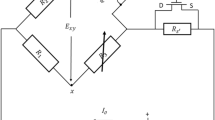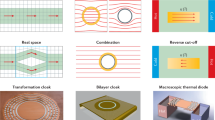Abstract
A thermoacoustic thermophone is a classical device wherein an alternating current passes through a thin heating element to emit sound. The newly emerging micro- and nanotechnology has not only greatly improved such a device’s performance, but also expended its new potential functions such as serving as directional ultrasound sources, phased arrays, or even in some audible sound applications. So far, most investigations on thermoacoustic thermophones are on experimental parts. Besides, the existing theoretic analysis generally adopted a fundamental equation for characterizing the surrounding gas which unfortunately could only consider the heat conduction effect. However, the transient volume and pressure change in an ideal gas caused by the periodic heating would definitely trigger the flow process, which in fact contributed to most of the phenomena occurring in small scale. Here, to disclose the actual working process of the thermoacoustic thermophone and the mechanisms thus involved, we developed a computational model to systematically describe both the gas flow dynamics and heat transfer behavior for the first time. Some important physical parameter variations initiated by the alternating voltage and the corresponding double frequency heat flux, such as pressure, velocity, temperature, etc., were successfully revealed. Discoveries on such variations paved the way for the identification of critical factors that affected the sound pressure, which as a result would serve as a valuable reference for designing a thermoacoustic thermophone in the near future.








Similar content being viewed by others
References
Arnold HD, Crandall IB (1917) The thermophone as a precision source of sound. Phys Rev 10:22–38
Barber R, Emerson DR (2006) Challenges in modeling gas-phase flow in micro channels: from slip to transition. Heat Transf Eng 27(4):3–12
Beskok A, Karniadakis GE (1999) A model for flows in channels, pipes, and ducts at micro and nano scales. Microsc Therm Eng 43:3–10
Braun F (1898) Notiz uber thermophonie. Ann Der Physik 65:358–360
Chen X (1996) Kinetic theory of gases and its applications to the studies of heat transfer and fluid flow (in Chinese). Tsinghua University Press, Beijing
De Lange P (1915) On thermophones. Proc R Soc Lond 91A:239–241
Hadjiconstantinou NG (2005) Oscillatory shear-driven gas flows in the transition and free-molecular-flow regimes. Phys Fluids 17:100611
Hadjiconstantinou NG, Simek O (2002) Constant-wall-temperature Nusselt number in micro and nano-channels. ASME J Heat Transf 124:356–364
Karniadakis G, Beskok A, Aluru N (2005) Micro flows and nano flows: fundamentals and simulation. Springer, New York
Kranz FW (1923) Minimum intensity for audition. Phys Rev 21:573–584
Liu J (2001) Micro/nano scale heat transfer (in Chinese). Science Press, Beijing
Liu J, Nie XB, Chen SY, Robbins MO (2007) A continuum–atomistic simulation of heat transfer in micro- and nano-flows. J Comput Phys 227:279–291
Mohamed GH (1999) The fluid mechanics of micro devices. J Fluid Eng 121:5–33
Morini GL, Yang YH, Chalabi H, Lorenzini M (2011) A critical review of the measurement techniques for the analysis of gas microflows through microchannels. Exp Thermal Fluid Sci 35:849–865
Nishanth D, Abhishek A, Amit A (2007) Analytical solution of gaseous slip flow in long microchannels. Int J Heat Mass Transfer 50:3411–3421
Niskanen AO, Hassel J, Tikander M, Maijala P, Grönberg L, Helistö P (2009) Suspended metal wire array as a thermoacoustic sound source. Appl Phys Lett 95:163102
Preece WH (1879–1880) On some thermal effects of electric currents. Proc R Soc Lond 30:408–411
Sharipov F (2011) Data on the velocity slip and temperature jump on a gas–solid interface. J Phys Chem Ref Data 40:023101
Sharipov F, Kalempa D (2008) Oscillatory Couette flow at arbitrary oscillation frequency over the whole range of the Knudsen number. Microfluid Nanofluid 4:363–374
Shinoda H, Nakajima T, Ueno K, Koshida N (1999) Thermally induced ultrasonic emission from porous silicon. Nature (London) 400:853
Shokouhmand H, Bigham S, Isfahani RN (2011) Effects of Knudsen number and geometry on gaseous flow and heat transfer in a constricted micro channel. Heat Mass Transfer 47:119–130
Wente EC (1922) The thermophone. Phys Rev 19:333–345
Xiao L, Chen Z, Feng C, Liu L, Bai ZQ, Wang Y, Qian L, Zhang YY, Li QQ, Jiang KL, Fan SS (2008) Flexible, stretchable, transparent carbon nanotube thin film loudspeakers. Nano Lett 8(12):4539–4545
Xu XM (2003) The physics of sound (in Chinese). Science Press, Beijing
Yang SM, Tao WQ (1998) Heat transfer (3rd ed) (in Chinese). Higher Education Press, Beijing
Zhang TT, Jia L, Wang ZC (2008) The application of homotopy analysis method for 2-dimensional steady slip flow in micro channels. Phys Lett A372:3223–3237
Zhang TT, Jia L, Wang ZC, Li CW (2009) Slip flow characteristics of compressible gaseous in micro channels. Energy Convers Manage 50:1676–1681
Acknowledgments
This work is supported by the National Natural Science Foundation of China under Grant 11004205.
Author information
Authors and Affiliations
Corresponding author
Rights and permissions
About this article
Cite this article
Yang, Y., Liu, J. Computational characterization on the thermoacoustic thermophone effects induced by micro/nano-heating elements. Microfluid Nanofluid 14, 873–884 (2013). https://doi.org/10.1007/s10404-012-1121-5
Received:
Accepted:
Published:
Issue Date:
DOI: https://doi.org/10.1007/s10404-012-1121-5




